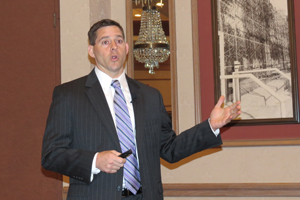Brian Mormino by Seth Clevenger/Transport Topics
COLUMBUS, Ind. — Today’s heavy-duty truck engine architecture with diesel particulate filters, exhaust gas recirculation and selective catalytic reduction aftertreatment will not need to change dramatically under the next round of federal greenhouse-gas standards, an executive at engine maker Cummins Inc. predicted.
That consistency in engine structure will enable manufacturers such as Cummins to focus instead on improving efficiency and reliability for customers, Brian Mormino, Cummins’ executive director for worldwide environmental strategy and compliance, said here March 25 during ACT Research’s seminar.
He also said Cummins expects the Phase 2 rule to retain separate certification and standards for engines and vehicles, an approach that Cummins supports.
While the Phase 1 standards created the foundation for greenhouse-gas regulation in the trucking industry, the next round will "push the boundaries more," Mormino said.
Although it’s not yet known how stringent the new standards will be, Mormino said further improvements to engine efficiency likely will be derived from reduced friction and improved aftertreatment efficiency.
Mormino also noted that 2014 was a great year for truck sales, even as the industry implemented the first-ever rule for greenhouse-gas emissions in commercial vehicles.
“The regulation was implemented without a bump in the road,” he said.


